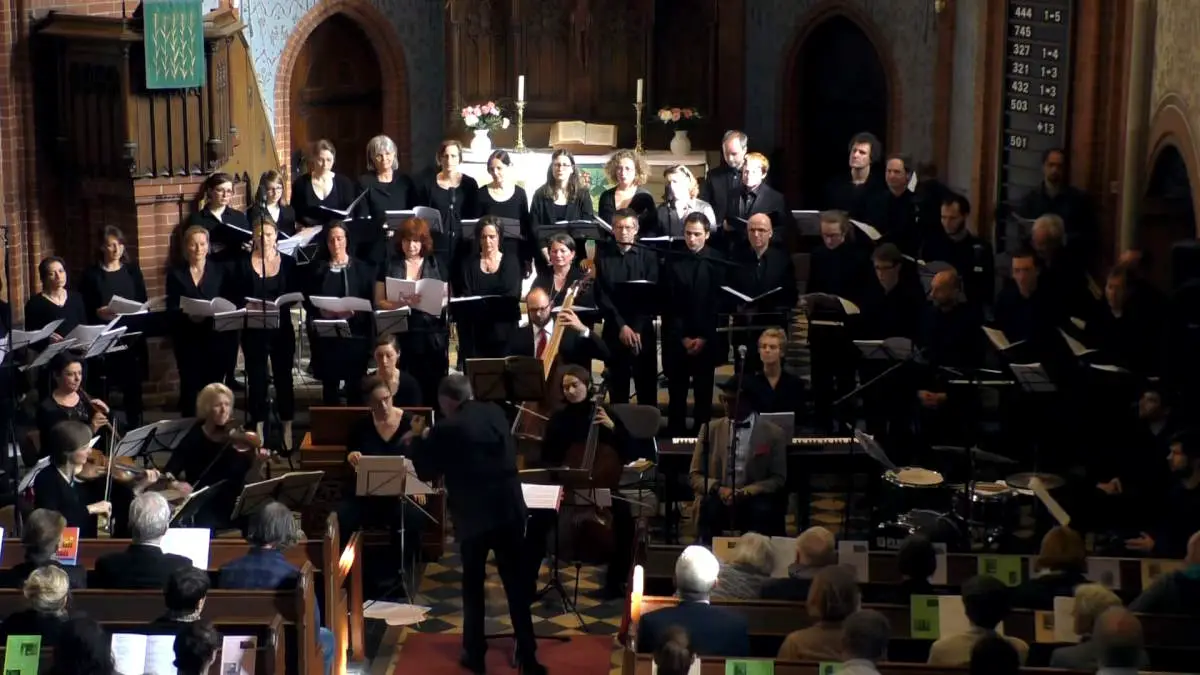Conducted by Kristian Commichau, the vocal-concertisten performs Johann Sebastian Bach’s Nach dir, Herr, verlanget mich (For Thee, O Lord, I long), BWV 150, an early church cantata. Recorded at the Inselkirche Hermannswerder in Potsdam, Germany, in 2015.
Johann Sebastian Bach’s Nach dir, Herr, verlanget mich (For Thee, O Lord, I long)
Johann Sebastian Bach’s “Nach dir, Herr, verlanget mich” (For Thee, O Lord, I long), BWV 150, is an early church cantata that holds a special place in Bach’s oeuvre due to its unique characteristics. Believed to be one of his earliest surviving cantatas, possibly composed in Arnstadt around 1707, it reflects a young Bach experimenting with form and texture. This work is distinctive for its sparse orchestration and the prominent role of the chorus, marking a departure from the more soloist-driven format of many other cantatas. The text combines verses from Psalm 25 with poetry by an unknown librettist, woven into a fabric of spiritual longing and penitence, possibly intended for a penitential service.
- Sinfonia: This instrumental opening in B minor sets a somber tone with its chromatic descent, embodying a sense of longing and lament. The use of the bassoon along with two violins creates a textured, melancholic atmosphere, introducing thematic material that recurs throughout the cantata.
- Nach dir, Herr, verlanget mich (Chorus): The first choral movement immediately follows the sinfonia, using the same chromatic motifs to express a deep yearning for divine guidance. The chorus and instruments interweave, echoing the psalm’s plea for hope and salvation with a profound sense of devotion.
- Doch bin und bleibe ich vergnügt (Aria for Soprano): This aria stands out for its introspective quality, with the soprano soloist reflecting on a contented acceptance of God’s will amidst life’s trials. The accompaniment of two violins underscores the text’s emotive depth, highlighting Bach’s ability to convey complex emotions through music.
- Leite mich in deiner Wahrheit (Chorus): A return to choral texture, this movement seeks divine guidance with a plea for truth and teaching. It’s short and segmented, yet dense with episodic shifts that capture the multifaceted nature of seeking enlightenment and understanding.
- Zedern müssen von den Winden (Aria for Alto, Tenor, and Bass): This trio aria is notable for its depiction of resilience in the face of adversity, likening believers to cedars that withstand storms. The movement’s major key and the lively continuo part contrast with the preceding movements, offering a sense of hope and strength.
- Meine Augen sehen stets zu dem Herrn (Chorus): Here, the chorus reaffirms a steadfast gaze towards the Lord, embodying a serene trust in divine providence. The movement’s texture is rich, with instrumental and vocal lines blending to create a celestial haze that uplifts the spirit.
- Meine Tage in dem Leide (Chaconne): The closing movement is a profound chaconne, built over a ground bass that mirrors the opening sinfonia’s motif in inversion. This structure symbolizes a journey from sorrow to joy, encapsulating the cantata’s thematic journey. The orchestration here, suggestive of strumming guitars, adds a baroque sense of drama and conclusion to the work.
“Nach dir, Herr, verlanget mich” is a testament to Bach’s early mastery of the cantata form, blending biblical scripture with contemporary poetry to explore themes of longing, faith, and divine guidance. Its experimental nature, both in terms of musical form and theological expression, marks it as a significant piece in Bach’s development as a composer, offering insights into his evolving musical and spiritual landscape.
vocal-concertisten

The VOCAL-CONCERTISTEN was founded in 1987 as a project choir called “norddeutsche vocal-concertisten” by Kristian Commichau, who still directs the choir today.
Curriculum vitae of Prof. Kristian Commichau
Since the chamber choir has shifted its focus to the Berlin area, it has been called “vocal-concertisten”. It is self-sustaining as an association and is not tied to any institution.
The members are experienced, partly trained singers from Berlin and Potsdam, but also from other cities in Germany. The choir has won prizes at national and international competitions. It has collaborated with artists such as Christine Schäfer, Annette Dasch, Christiane Oelze, Alastair Thompson, Thomas Quasthoff, and Jan Kobow.
Numerous concert tours have taken the choir abroad: to Estonia and Russia, Italy, Hungary and the Czech Republic, Israel (Israel in Egypt by George Frideric Handel), Belgium and the Netherlands (A German Requiem by Johannes Brahms at the Concertgebouw Amsterdam), to Australia (Johann Sebastian Bach’s first St. Matthew Passion with period instruments on the continent), on the occasion of the Bach Year and at the invitation of the Goethe-Institut to India, a trip to South America to Chile, Sao Paulo and Montevideo (Mozart’s Requiem), to North Wales, Canada, Ghana, Bolivia (first performance of Bach’s St. John Passion) and most recently to China, now with regular support from the Goethe-Institut.
The special features of this choir include opera performances (2001 King Arthur by Purcell and 2005 The Pirates of Penzance by Gilbert & Sullivan) as well as musical plays (2005 Possible Encounter by Paul Barz and in 2008 the world premiere of Orpheus Britannicus by Lars Wernecke in collaboration with the choir and orchestra of the University of Potsdam).
But the vocal-concertists have also far exceeded the boundaries of ordinary choral work with many other projects: e.g. in 2001 and 2006 performance of the Mozart Requiem with contemplative intertexts by and with Walter Jens; In 2003, again in cooperation with the University of Potsdam, a lecture concert with Friedrich Schorlemmer; In 2010 with Swinging Bach and in 2015 with Glorious Sounds, an excursion into jazz or sound spaces, a collaboration with the sound artist and overtone singer Cora Krötz.
Sources
- Nach dir, Herr, verlanget mich, BWV 150 on Wikipedia
- vocal-concertisten official website
